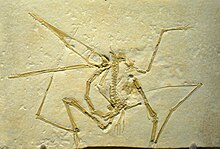Pterodactyloidea
| Pterodactyloids | |
|---|---|

| |
| Cast of a Pterodactylus antiquus specimen, Carnegie Museum of Natural History | |
| Scientific classification | |
| Domain: | Eukaryota |
| Kingdom: | Animalia |
| Phylum: | Chordata |
| Order: | †Pterosauria |
| Clade: | †Caelidracones |
| Suborder: | †Pterodactyloidea Plieninger, 1901 |
| Subgroups | |
| |
| Synonyms | |
|
Dracochira Haeckel, 1895 | |
Pterodactyloidea (derived from the Greek words πτερόν (pterón, for usual ptéryx) "wing", and δάκτυλος (dáctylos) "finger" meaning "winged finger", "wing-finger" or "finger-wing") is one of the two traditional suborders of pterosaurs ("wing lizards"), and contains the most derived members of this group of flying reptiles. They appeared during the middle Jurassic Period, and differ from the basal (though paraphyletic) rhamphorhynchoidea by their short tails and long wing metacarpals (hand bones). The most advanced forms also lack teeth. Many species had well developed crests on the skull, a form of display taken to extremes in giant-crested forms like Nyctosaurus and Tupandactylus. Pterodactyloids (specifically the family Azhdarchidae) were the last surviving pterosaurs when the order became extinct at the end of the Cretaceous Period, together with the non-avian dinosaurs and most marine reptiles.
"Pterodactyl" is also a common term for pterodactyloid pterosaurs, though it can also be used to refer to Pterodactylus specifically or (incorrectly) to pterosaurs in general. Well-known examples of pterodactyloids include Pterodactylus, Dsungaripterus, Pteranodon, and Quetzalcoatlus.
In 2014, fossils from the Shishugou Formation of China were classified as the most basal pterodactyloid yet found, Kryptodrakon. It is about 5 million years older than the oldest previously known confirmed specimens.[1] Previously, a fossil jaw recovered from the Middle Jurassic Stonesfield Slate formation in the United Kingdom, was considered the oldest known. This specimen supposedly represented a member of the family Ctenochasmatidae,[2] though further examination suggested it actually belonged to a teleosaurid stem-crocodilian instead of a pterosaur.[1]
Classification
Pterodactyloidea is traditionally considered to be the group of short-tailed pterosaurs with long wrists (metacarpus), compared with the relatively long tails and short wrist bones of basal pterosaurs ("rhamphorhynchoids"). In 2004, Kevin Padian formally defined Pterodactyloidea as an apomorphy-based clade containing those species possessing a metacarpal at least 80% of the length of the humerus, homologous with that of Pterodactylus.
A subgroup of pterodactyloids, called the Lophocratia, was named by David Unwin in 2003. Unwin defined the group as the most recent common ancestor of Pterodaustro guinazui and Quetzalcoatlus northropi, and all its descendants.[3] This group was named for the presence of a head crest in most known species, though this feature has since been found in more primitive pterosaurs and was probably an ancestral feature for all pterodactyloids.[4]
There are competing theories of pterodactyloid phylogeny. Below is a cladogram showing the results of a phylogenetic analysis presented by Andres, Clark & Xu, 2014. This study found the two traditional groupings of ctenochasmatoids and kin as an early branching group, with all other pterodactyloids grouped into the Eupterodactyloidea.[1]
| Caelidracones |
| ||||||
Some studies based on a different type of analysis have found that this basic division into primitive (archaeopterodactyloid) and advanced (eupterodactyloid) species may not be correct. In 2014, Steven Vidovic and David Martill concluded that several pterosaurs traditionally thought of as archaeopterodactyloids, specifically Gladocephaloideus, Cycnorhamphus, Aurorazhdarcho, Aerodactylus, and Ardeadactylus, may actually have been more closely related to ornthocheiroids and azhdarchoids. They found that Pterodactylus itself was actually more primitive than both this new group, the Aurorazhdarchidae, and the classic archaeopterodactyloid ctenochasmatids. The results of their analysis are shown below.[5]
| Pterodactyloidea |
| ||||||||||||
References
- ^ a b c Andres, B.; Clark, J.; Xu, X. (2014). "The Earliest Pterodactyloid and the Origin of the Group". Current Biology. doi:10.1016/j.cub.2014.03.030.
- ^ Buffetaut, E. and Jeffrey, P. (2012). "A ctenochasmatid pterosaur from the Stonesfield Slate (Bathonian, Middle Jurassic) of Oxfordshire, England." Geological Magazine, (advance online publication) doi:10.1017/S0016756811001154
- ^ Unwin, D. M., (2003). "On the phylogeny and evolutionary history of pterosaurs." Pp. 139-190. in Buffetaut, E. & Mazin, J.-M., (eds.) (2003). Evolution and Palaeobiology of Pterosaurs. Geological Society of London, Special Publications 217, London, 1-347.
- ^ Witton, Mark (2013). Pterosaurs: Natural History, Evolution, Anatomy. Princeton University Press. ISBN 978-0691150611.
- ^ Vidovic, S. U.; Martill, D. M. (2014). "Pterodactylus scolopaciceps Meyer, 1860 (Pterosauria, Pterodactyloidea) from the Upper Jurassic of Bavaria, Germany: The Problem of Cryptic Pterosaur Taxa in Early Ontogeny". PLoS ONE. 9 (10): e110646. doi:10.1371/journal.pone.0110646.
{{cite journal}}: CS1 maint: unflagged free DOI (link)








